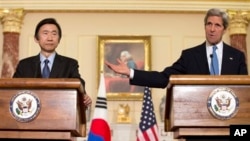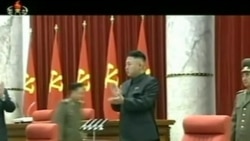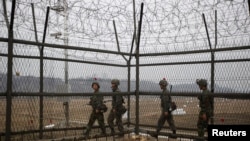U.S. Secretary of State John Kerry said Tuesday that the United States will defend itself and its ally South Korea against military threats from North Korea, and says Washington will not accept North Korea as a nuclear state.
Kerry, speaking in Washington alongside South Korean Foreign Minister Yun Byung-se, called Pyongyang's recent threats of military action against South Korea and the United States "provocative, dangerous and reckless." He said the United States is "fully prepared and capable" of defending its interests, and said he believes "the DPRK [North Korea] knows that."
Kerry's comments came hours after North Korea said it would "quickly begin" to restart its idled nuclear reactor at Yongbyon, with the aim of building more nuclear weapons and addressing the impoverished country's electricity shortage.
Official North Korean radio said the restart will include a uranium enrichment plant and a five-megawatt reactor that can produce weapons-grade plutonium.
Related video of Korea tensions:
United Nations Secretary-General Ban Ki-moon said international tensions had, in his words, "gone too far." He also warned that the North is on a "collision course" with the international community.
The secretary-general said he is convinced no one intends to attack North Korea, and that negotiations are the only way to resolve the crisis.
North Korea agreed to halt operations at the plutonium-based Yongbyon reactor and destroy its cooling tower as part a 2007 aid-for-disarmament deal at the now-stalled six-party denuclearization talks.
But last week, North Korean leader Kim Jong Un said developing atomic weapons is one of the country's top priorities.
Mark Fitzpatrick, a senior analyst at the London-based International Institute for Strategic Studies (IISS), says experts believe it would take about six months to get the reactor running again.
"We're not looking at an immediate production of plutonium, but once they get started, they would be down the path to expanding their nuclear arsenal," Fitzpatrick said.
North Korea, angered by tough U.N. sanctions passed in response to its third nuclear test in February and its latest satellite launch, has been making threats for weeks. They include turning Seoul into a "sea of fire" and firing rockets at U.S. military bases in Hawaii, Guam and Japan.
Kerry, speaking in Washington alongside South Korean Foreign Minister Yun Byung-se, called Pyongyang's recent threats of military action against South Korea and the United States "provocative, dangerous and reckless." He said the United States is "fully prepared and capable" of defending its interests, and said he believes "the DPRK [North Korea] knows that."
Kerry's comments came hours after North Korea said it would "quickly begin" to restart its idled nuclear reactor at Yongbyon, with the aim of building more nuclear weapons and addressing the impoverished country's electricity shortage.
Official North Korean radio said the restart will include a uranium enrichment plant and a five-megawatt reactor that can produce weapons-grade plutonium.
Related video of Korea tensions:
United Nations Secretary-General Ban Ki-moon said international tensions had, in his words, "gone too far." He also warned that the North is on a "collision course" with the international community.
The secretary-general said he is convinced no one intends to attack North Korea, and that negotiations are the only way to resolve the crisis.
Tensions Rising on Korean Peninsula
Tensions Rising on Korean Peninsula- February 12: North Korea carries out third nuclear test
- March 27: North Korea cuts military hotline with South Korea
- March 28: U.S. B-2 bombers fly over Korean peninsula
- March 30: North Korea says it has entered a "state of war" with South Korea
- April 3: North Korea blocks South Korean workers from Kaesong
- April 4: North Korea moves a missile to its east coast
- April 9: North Korea urges foreigners to leave the South. The U.S. and South Korea raise alert level
- April 14: US Secretary of State John Kerry offers talks with Pyongyang if it moves to scrap nuclear weapons
- April 16: North Korea issues threats after anti-Pyongyang protests in Seoul
- April 29: North Korea holds back seven South Koreans at Kaesong
- April 30: North Korea sentences American to 15 years hard labor for hostile acts
- May 20: North Korea fires projectiles for a consecutive third day
- May 24: North Korean envoy wraps up China visit for talks on Korean tensions
- June 7: South Korea accepts Pyongyang's offer of talks on Kaesong and other issues
But last week, North Korean leader Kim Jong Un said developing atomic weapons is one of the country's top priorities.
Mark Fitzpatrick, a senior analyst at the London-based International Institute for Strategic Studies (IISS), says experts believe it would take about six months to get the reactor running again.
"We're not looking at an immediate production of plutonium, but once they get started, they would be down the path to expanding their nuclear arsenal," Fitzpatrick said.
North Korea, angered by tough U.N. sanctions passed in response to its third nuclear test in February and its latest satellite launch, has been making threats for weeks. They include turning Seoul into a "sea of fire" and firing rockets at U.S. military bases in Hawaii, Guam and Japan.














